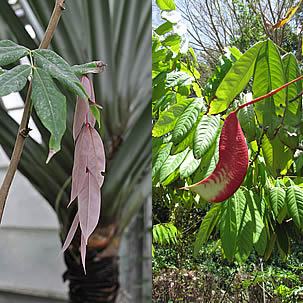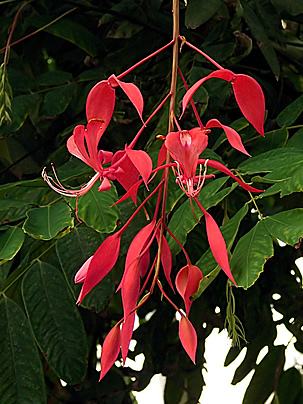The Pride of Burma (Amherstia nobilis) is a tropical, evergreen tree species that stands out for its spectacular flowering. It is native to the tropical forests of Burma, Asia, although it is currently rare in its habitat. It has a rounded, globular, and full crown, with a rough and brownish trunk, and a small to medium size, reaching 23 to 66 feet in height (7 to 20 meters). Its leaves are pinnate, with 6 to 8 oblong, large leaflets, dark green on the upper side and light green on the lower side.
As soon as they emerge, the leaves are curiously pendant, pale, and reddish, creating a significant point of interest even when the plant is not in bloom. The inflorescences are a show on their own, long and pendant, with uniquely shaped flowers, long stamens, and vivid red color, contrasting with small yellow spots. In favorable conditions, it blooms throughout the year, with greater intensity in spring and summer. The fruits are pod-type, dehiscent, and woody when mature.

It’s impossible not to be enchanted by the Pride of Burma! It’s no wonder that many consider it the most beautiful of all trees. Its pendant inflorescences are true nature’s jewels and enhance the landscaping project, always as a highlight. Despite thriving in our tropical gardens, due to its challenging propagation, it is still rare in nurseries and garden centers. This rarity contributes to the high value of the seedling as well, with elevated prices.
Use the Pride of Burma as a focal point in spaces that allow close observation of the flowers. It is ideal for areas with poor drainage but not permanently waterlogged, where other trees might perish.
It should be grown in full sun, in fertile soil enriched with organic matter, and regularly irrigated. It appreciates a humid tropical climate, making its cultivation in more continental areas complicated. In dry weather, it burns the tips of the leaves and ceases growth. It also does not tolerate drought, strong winds, or intense cold.
When planting, prepare the planting hole well by adding well-rotted manure and bone meal for good initial development. It propagates through air layering and seeds, which should be collected as soon as the fruits open. Pride of Burma seeds can be soaked in clean water for 24 hours before planting and usually germinate easily.


